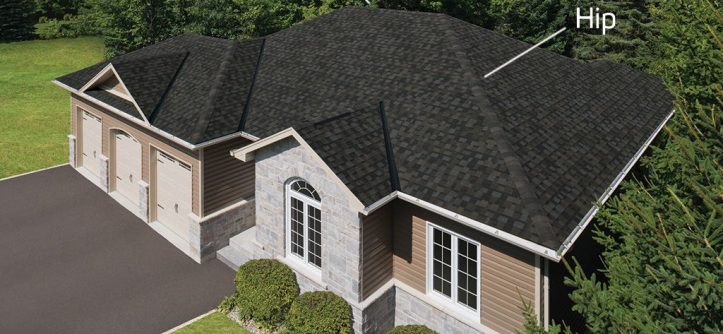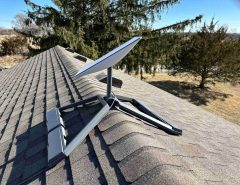A hip roof has slopes on all four sides, while a gable roof has two sloping sides that meet at a ridge. Hip roofs offer enhanced stability, whereas gable roofs provide easier construction and more attic space.
Choosing between a hip roof and a gable roof depends on factors like architectural style, climate resilience, and space requirements. Hip roofs, with their inward sloping design, are known for their durability and wind resistance, making them suitable for areas prone to severe weather.
They also contribute to a more uniform look but can be costlier due to their complexity. Gable roofs, on the other hand, are popular for their classic triangular shape and the added benefit of extra ventilation and ceiling space under the peak. They might be the preferred choice for those on a budget, thanks to their simpler design which often results in lower construction costs. Consideration of these factors can guide homeowners to the roof style that best suits their needs and aesthetic preference.
Introduction To Roof Designs
When it comes to constructing a home or building, the silhouette of the roof plays a pivotal role in defining its character and durability. Roof designs are not just an aesthetic choice; they also serve functional purposes, protecting the structure from the elements while providing insulation and ventilation. This makes understanding the various roof types, including the popular hip and gable roofs, crucial for both homeowners and builders.
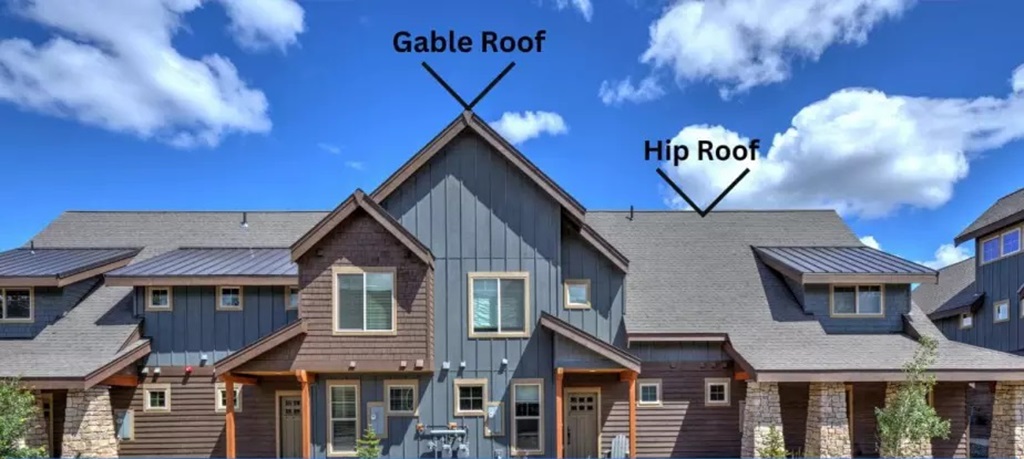
Understanding The Basics Of Roof Architecture
Roof architecture is a field replete with terminology and concepts that can be overwhelming for the uninitiated. At its core, it involves the design and construction of a roof’s framework, which includes the rafters, beams, and trusses. This framework not only supports the covering materials, such as shingles or tiles, but also defines how well the roof withstands weather and environmental pressures. A solid understanding of basic roof architecture is the key to making informed decisions about which roof type is best suited for a specific climate or aesthetic preference.
The Importance Of Choosing The Right Roof Design
Choosing the right roof design is more than an aesthetic decision; it’s a matter of functionality and longevity. The correct roof design ensures proper drainage, enhances energy efficiency, and can reduce maintenance costs. More importantly, it can greatly impact a home’s ability to withstand local weather conditions such as heavy snowfall, intense winds, or continuous rainfall. Therefore, taking the time to compare roof types, considering both their benefits and limitations, is essential for any construction or renovation project.
Overview Of Hip Roof And Gable Roof
Hip and gable roofs are two of the most commonly implemented styles in residential construction. The hip roof, recognizable by its sloping sides that connect to form a ridge, offers excellent stability and resistance to wind. Gable roofs, with their distinctive triangular shape, provide ample space for an attic or vaulted ceilings and are known for efficiently shedding water and snow.
| Hip Roof | Gable Roof |
|---|---|
| Slopes on all four sides | Two slopes forming a peak |
| Good resistance to wind | Excellent water and snow shedding |
| More complex construction | Simpler design, easier to construct |
The table above outlines the basic differences between hip and gable roofs. When selecting between these two, factors such as geographical location, building shape, and personal taste play a significant role. Understanding their unique attributes and limitations will guide homeowners and architects in choosing a roof design that not only looks good but functions optimally for years to come.
The Hip Roof
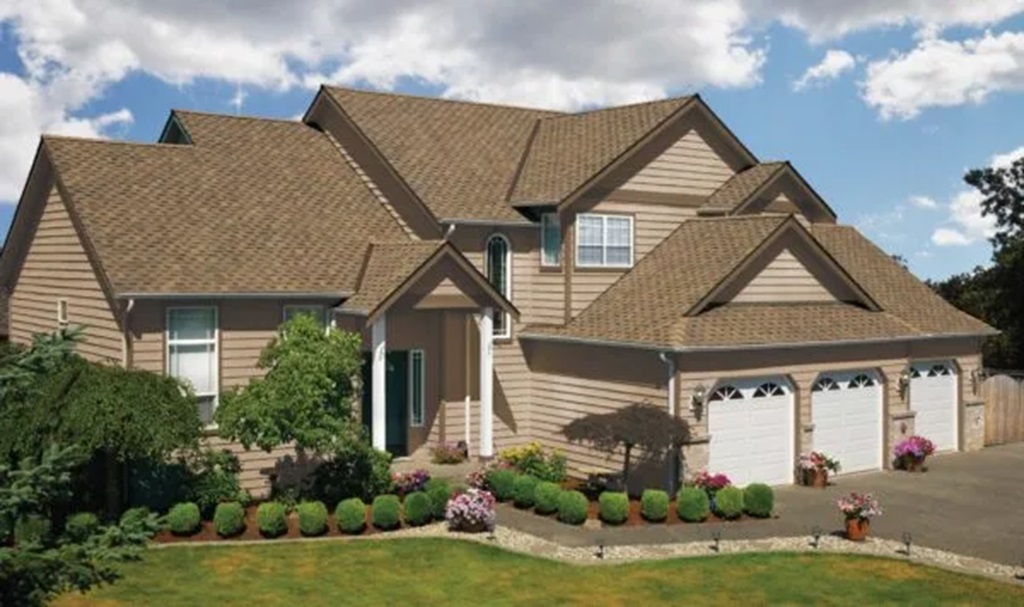
Defining The Hip Roof Structure
A hip roof is characterized by slopes on all four sides that converge at the top to form a ridge. Unlike the gable roof with two sloping sides and a triangular extension, every side of a hip roof gently inclines towards the structure’s walls. This design reduces the possibility of damage from strong winds and heavy snowfall, making it a robust choice for areas prone to extreme weather conditions. The internal framework of hip roofs often requires complex systems of rafters and trusses to ensure stability and strength.
The Aesthetics Of Hip Roof Design
Hip roofs exude an architectural beauty that enhances the overall vibe of a property. The symmetry they offer can complement a wide range of house styles—from classic cottages to contemporary residences. The seamless design of hip roofs provides a clean and crisp outline that many find visually pleasing, as it blends effortlessly with the landscape, giving a compact and finished look to a building’s silhouette.
Advantages Of A Hip Roof
- Weather Resistance: Due to its design, a hip roof provides superior resistance to wind and rain, making it ideal for areas with frequent severe weather.
- Energy Efficiency: Hip roofs typically offer excellent ventilation and the option for additional attic space, which can help in maintaining a consistent indoor temperature.
- Durability: The self-bracing nature of hip roofs makes them more stable and durable over time.
Disadvantages Of A Hip Roof
- Complex Design: The construction of a hip roof can be more complex and time-consuming than other types of roofs.
- Cost: The complexity often translates into higher labor and material costs.
- Limited Attic Space: Hip roofs may result in less usable attic space compared to gable roofs.
Best Use Cases For Hip Roofs
Hip roofs shine in regions where severe winds, heavy snowfall, and rains are common. They suit a variety of architectural styles, particularly those that benefit from added character and appeal. Bungalows, ranch homes, and cottages often feature hip roofs to harness their practical benefits while enhancing their quaint charm and symmetry.
Materials And Cost Considerations For Hip Roofs
Choosing the right material for a hip roof can impact both its cost and longevity. Common materials include asphalt shingles, metal, and tiles. Each comes with its own price point and longevity:
| Material | Cost (Per Square Foot) | Longevity |
|---|---|---|
| Asphalt Shingles | Low | 15-30 years |
| Metal | Medium | 40-70 years |
| Tiles | High | 50-100 years |
Prospective homeowners and builders should consider the initial investment against the expected lifespan and maintenance costs when deciding on the material for their hip roof.
The Gable Roof
The classic silhouette of the gable roof has epitomized the idea of a home across various cultures and historical periods. This universal design is as practical as it is aesthetically pleasing, and its adaptability has allowed it to endure as a preferred choice for many homeowners. Below, let’s explore the details that make the gable roof a timeless architectural element.
Defining The Gable Roof Structure
At its core, the gable roof comprises two sloping sides that meet at a central ridge, creating a peak or triangle on the ends of a building. This design allows for efficient water runoff and can combat heavy snowfall, making it a favorite in climates with severe weather. Its inherent simplicity also translates to easier construction and maintenance.
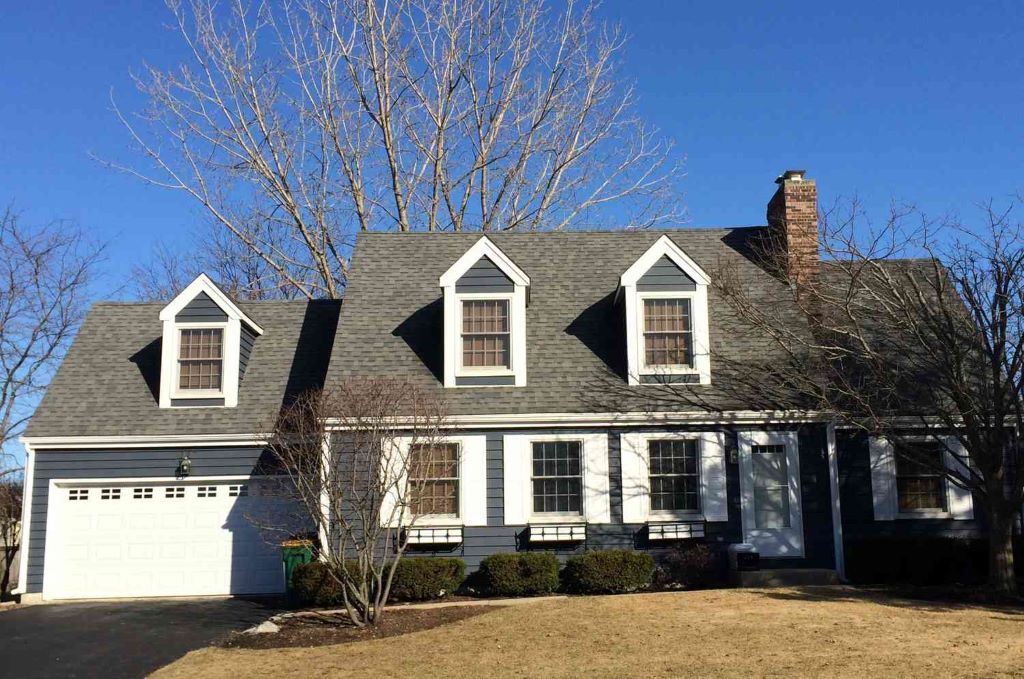
The Aesthetics Of Gable Roof Design
The prominence of the gable roof is not just about function; it also has an undeniable charm. It’s a testament to the fact that simplicity meets elegance in architectural design. From quaint cottages to modern farmhouses, the pitched roof creates an inviting visual appeal that many find resonant of comfort and nostalgia.
Advantages Of A Gable Roof
- Simple to design and build, resulting in lower construction costs
- Excellent drainage capabilities prevent water-related issues
- Provides additional attic space or vaulted ceilings, ideal for storage or living space
- Easily ventilated, promoting airflow that can help regulate temperature
Disadvantages Of A Gable Roof
- Potential for wind damage, especially if not properly braced
- Structural integrity can be compromised if roof materials are not adequately attached
Best Use Cases For Gable Roofs
Gable roofs shine in areas with heavy rain and snow, as their steep pitch promotes quick runoff, preventing water buildup. They’re also ideal for those desiring an attic space for additional storage or living quarters. This roof type complements various styles, from traditional to contemporary homes.
Materials And Cost Considerations For Gable Roofs
| Material | Cost | Longevity |
|---|---|---|
| Asphalt Shingles | Low to moderate | 15-30 years |
| Metal | Moderate to high | 40-70 years |
| Wood Shakes | High | 25-40 years |
| Slate | Very high | 100+ years |
While gable roofs can be cost-effective, the choice of materials greatly influences the overall expense and longevity. Asphalt shingles offer an economical entry point, while premium materials like slate come with a higher price tag but provide exceptional durability.
Comparing Hip Roof And Gable Roof
The decision between a hip roof and a gable roof holds significant importance for both homeowners and designers alike. This choice not only shapes the aesthetic appeal of a home but also influences its structural integrity, ability to weather the elements, and the potential for customization. Here, we will exhaustively compare the two, delving into their structural nuances, design flexibility, resilience to extreme conditions, practical aspects of installation and maintenance, cost implications, and how each aligns with various architectural styles.
Structural Differences And Their Impact
Hip roofs feature slopes on all four sides, which converge at the top to form a ridge. This design enhances their stability and allows for even distribution of weight—key factors in their robustness. Gable roofs, with their characteristic triangular shape, present two sloping sides that meet at a ridge, offering simplicity in design and construction.
Design Flexibility And Customization
Hip roofs boast an elegant symmetry that readily harmonizes with a range of house styles. Their structure is particularly conducive to venting and dormers, contributing to a tailored and functional design. Gable roofs, on the other hand, provide ample attic space and the opportunity for vaulted ceilings, granting a spacious and airy environment within.
Durability And Performance In Extreme Weather
When confronting harsh weather, both roof types possess strengths. Hip roofs, with their aerodynamic shape, are less susceptible to wind uplift and are typically the go-to choice in high-wind or hurricane-prone areas. Gable roofs, while offering easier snow and rain runoff, require precise installation to ensure they withstand severe conditions.
Ease Of Installation And Maintenance
The setup of a gable roof, with its straightforward design, often translates to a quicker and less complicated installation process compared to the multi-planed hip roof. Maintenance also tends to be simpler for gable roofs due to their accessible design, thereby potentially lowering long-term upkeep costs.
Cost-benefit Analysis
Cost considerations play a pivotal role in the decision-making process. Gable roofs are generally more budget-friendly due to their basic construction and less material usage. Conversely, hip roofs often entail higher initial expenses but could offer potential savings in terms of energy efficiency and reduced insurance premiums in certain regions.
Architectural Harmony With House Design
Hip and gable roofs each bring a distinct aesthetic that can complement corresponding architectural styles. Hip roofs seamlessly align with the design of cottages, bungalows, and modernist homes, enhancing their cosy and integrated appearance. Gable roofs, synonymous with classic American architecture, can accentuate the charm of Colonial, Cape Cod, and Craftsman houses, among others.
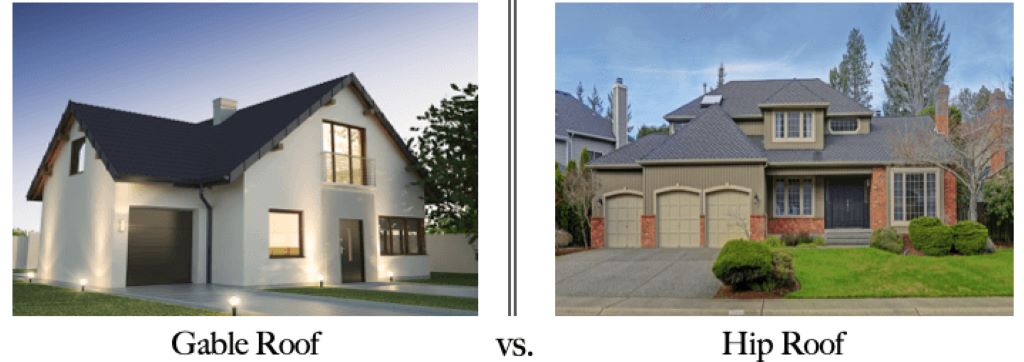
Making The Decision: Hip Or Gable Roof?
Making the decision between a hip roof and a gable roof is an important part of designing your home or building. Each roof type offers distinct advantages and architectural appeal. Understanding the differences, how they perform under various conditions, and their long-term value can ensure that you make an informed choice that aligns with your preferences and requirements. Below, we explore several key factors and real-world examples to guide you through this critical decision.
Factors To Consider When Choosing A Roof Design
Several elements play crucial roles in deciding whether a hip or gable roof fits your structure best. Here’s what to examine:
- Architectural Style: A hip roof often complements traditional homes, offering a consistent slope on all sides. In contrast, a gable roof, with its triangular shape, suits a more classic or colonial style.
- Cost Effectiveness: Gable roofs can be less expensive due to their simpler design, while hip roofs may require more materials and complex construction methods.
- Space Requirements: Consider attic space and ventilation. Gable roofs provide more room underneath for storage or additional living space.
The Role Of Climate In Roof Selection
Climate impacts how a roof performs. A hip roof’s design lends itself well to high wind regions, distributing force more evenly. Contrastingly, gable roofs might require additional reinforcements in such areas.
- Snow and Rain: Hip roofs offer excellent drainage and resist snow accumulation, which is beneficial in areas with heavy snowfall.
- High Winds: The aerodynamic shape of hip roofs makes them more stable during storms, reducing the risk of damage.
Assessing The Long-term Value Of Each Roof Type
When considering longevity and maintenance, hip roofs often provide better durability but may come at a higher initial cost. Gable roofs, while generally low-maintenance, can be more susceptible to damage if not properly constructed for your local climate.
| Roof Type | Longevity | Maintenance | Climate Suitability |
|---|---|---|---|
| Hip Roof | Excellent | Moderate | Most Climates |
| Gable Roof | Good | Low | Mild Climates |
Getting Professional Advice For Your Specific Needs
Consulting with a roofing expert or an architect is a wise step to ensure your roof choice is suited to your specific situation. These professionals will consider your individual needs, the local building codes, and the overall design aesthetic of your home.
Case Studies: Real-life Examples Of Hip And Gable Roofs
Exploring case studies of existing buildings with hip and gable roofs can provide practical insights. For instance, homes in coastal regions might predominantly feature hip roofs due to their resilience against high winds. On the other hand, suburban homes where snow is less of a concern may showcase the classic look of gable roofs. These examples show how the theoretical benefits of each roof type play out in real-world applications.
Frequently Asked Questions On Hip Roof Vs Gable Roof
Is A Hip Roof Better Than A Gable Roof?
A hip roof offers enhanced stability and resistance to wind compared to a gable roof. Its slanted design allows for better water runoff, reducing leaks. However, hip roofs can be more expensive and complex to construct.
Which Is More Expensive Gable Or Hip Roof?
A hip roof typically costs more than a gable roof due to its complex design and additional materials required.
What Are The Advantages And Disadvantages Of Hip Roofs?
Advantages of hip roofs include enhanced wind resistance and durability, plus they provide extra living space. Disadvantages encompass complex design leading to higher construction costs and potential water leaks if not properly maintained.
What Type Of House Has A Hip Roof?
A hip roof commonly adorns cottages, bungalows, and ranch-style homes, featuring slopes on all four sides that converge at the top.
Conclusion
Choosing between a hip roof and a gable roof depends on your individual needs, style preferences, and climate concerns. Hip roof design essentials: elevate your home’s style! Both offer distinct benefits and aesthetic appeal. As you weigh your options, consider durability, ventilation, and architectural harmony. Your final selection should enhance your home’s value and protect it for years to come, ensuring that your hip roof not only adds a touch of sophistication but also stands as a durable and well-integrated architectural feature.
Tags: architectural choices, best roof design, gable roof, hip roof, home architecture, home improvement, residential roofing, roof design, roofing styles, roofing trends
